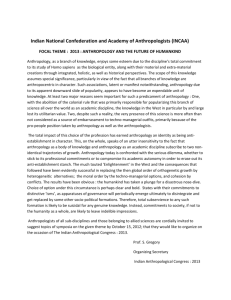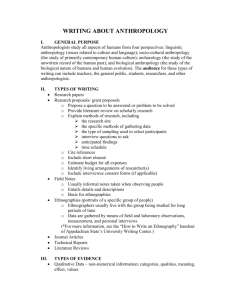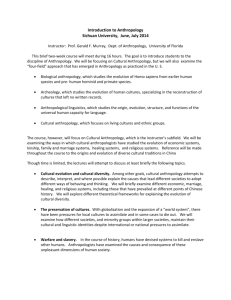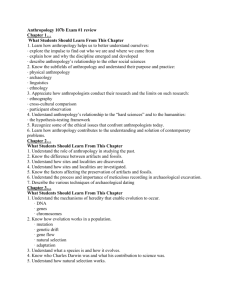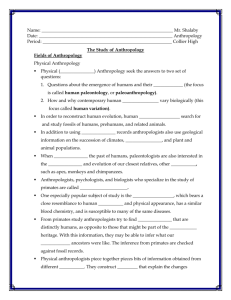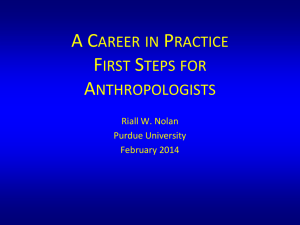downloade
advertisement
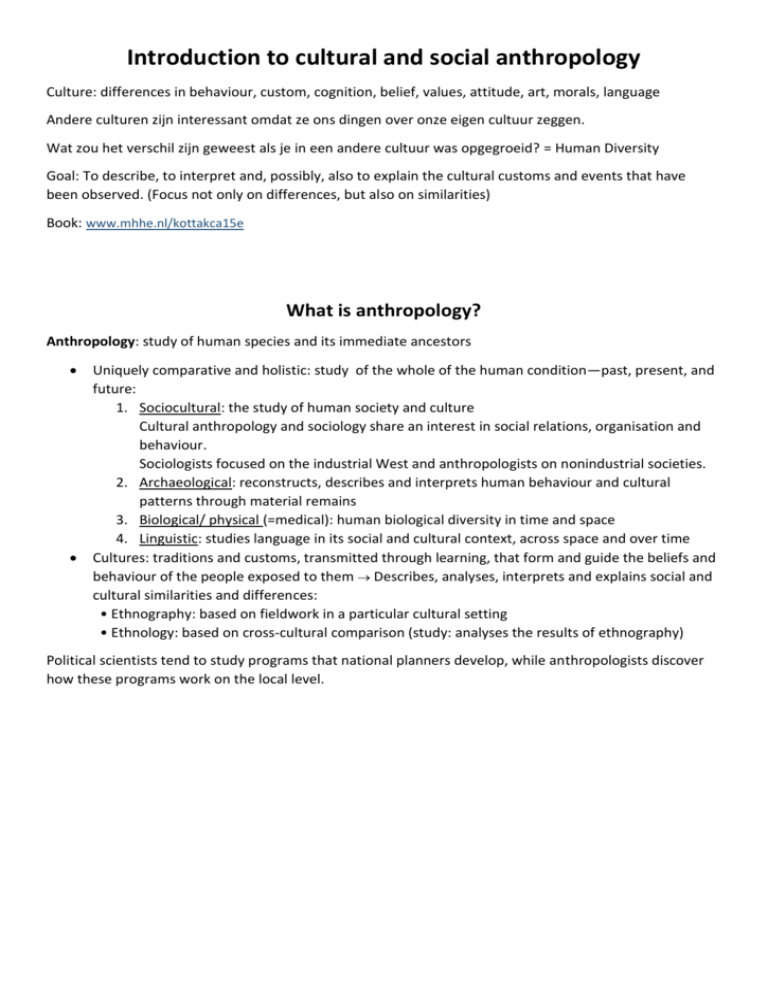
Introduction to cultural and social anthropology Culture: differences in behaviour, custom, cognition, belief, values, attitude, art, morals, language Andere culturen zijn interessant omdat ze ons dingen over onze eigen cultuur zeggen. Wat zou het verschil zijn geweest als je in een andere cultuur was opgegroeid? = Human Diversity Goal: To describe, to interpret and, possibly, also to explain the cultural customs and events that have been observed. (Focus not only on differences, but also on similarities) Book: www.mhhe.nl/kottakca15e What is anthropology? Anthropology: study of human species and its immediate ancestors Uniquely comparative and holistic: study of the whole of the human condition—past, present, and future: 1. Sociocultural: the study of human society and culture Cultural anthropology and sociology share an interest in social relations, organisation and behaviour. Sociologists focused on the industrial West and anthropologists on nonindustrial societies. 2. Archaeological: reconstructs, describes and interprets human behaviour and cultural patterns through material remains 3. Biological/ physical (=medical): human biological diversity in time and space 4. Linguistic: studies language in its social and cultural context, across space and over time Cultures: traditions and customs, transmitted through learning, that form and guide the beliefs and behaviour of the people exposed to them Describes, analyses, interprets and explains social and cultural similarities and differences: • Ethnography: based on fieldwork in a particular cultural setting • Ethnology: based on cross-cultural comparison (study: analyses the results of ethnography) Political scientists tend to study programs that national planners develop, while anthropologists discover how these programs work on the local level. Culture is learned Culture is learned through direct instruction and observation. Enculturation: the progress by which a child learns his/her culture. Human cultural learning depends on the uniquely developed human capacity to use symbols (signs that have no necessary or natural connection with the things for which they stand). Signs Signal - one meaning - animals Symbol - multiple meanings - context Symbolic thought is unique and crucial to cultural learning (verbal and nonverbal). Culture is located in and transmitted through groups. Culture is all-compassing: Culture includes features sometimes regarded as trivial or unworthy of serious study. Core values: key, basic or central values that integrate a culture. Humans have biological and cultural ways of coping with environmental stress: What’s good for an individual isn’t necessarily good for the group Many modern cultural patterns may be maladaptive in the long run. Universal: exists in every culture (distinguishes homo sapiens from other species) 1. Biological (infant dependency, complex brain) 2. Social (life in groups/’family’) General: exists in some but not all cultures Particular: distinctive or unique culture trait, pattern or integration Generations of anthropologists theorized about the relationship between ‘culture’ and ‘individual’/’personality’: Culture is contested Culture is public and individual Practice theory: individuals within society have diverse motives Preach and practice are not always the same Levels of culture: National culture: cultural features shared by citizens of the same nation International culture: cultural traditions that extend beyond national boundaries Subcultures: identifiable cultural patterns existing within a larger culture Ethnocentrism: tendency to view one’s own culture as superior and to use one’s own standards and values in judging outsiders. Cultural relativism: to know anther culture requires full understanding of its members’ beliefs and motivations. (not the same as ethical relativism) Human Rights: - Rights based on justice and morality beyond and superior to particular countries, cultures, and religions. Inalienable: nations cannot abridge or terminate them International: larger than and superior to individual nations and cultures Has arisen an awareness of the need to preserve cultural rights: rights vested in religious and ethnic minorities and indigenous societies. Intellectual property rights (IPR): to conserve each society’s cultural base – it’s core beliefs and principles. Mechanisms of cultural change: Diffusion: borrowing of traits between cultures Direct: when two cultures trade, intermarry or wage war on one another Forced: when one culture subjugates another and imposes its customs on the dominated group Indirect: when items move from group A to group C via group B without any first-hand contact between A and C Acculturation: exchange of features that results when groups have continuous first-hand contact Pidgin: a mixed language that develops to ease communication between members of different societies in contact Independent invention: the process by which humans innovate, creatively finding solutions to problems (reason for cultural generalities) Globalization: series of processes that work to make modern nations and people increasingly interlinked and mutually dependent (time/space compression) Forces promoting globalization: (economic, political, modern systems of transportation and communication) International commerce and finance Travel and tourism Transnational migration Mass media Multilocally: in different places and cultures at once Smith and Doyle: important distinction between two meanings of globalization: 1. Globalization as a fact New: 1. speed of global communication 2. scale (complexity and size) of global networks 3. volume of international transactions 2. Globalization as a contested ideology and policy Multinational corporations increasingly influence national policy Method and theory Ethnographic techniques - Direct, first-hand observation (participation) Naming phase Enthographic survey or census Conversation Interview schedule: form used to structure a formal, but personal, interview (face to face) Questionnaire: form used to obtain comparable information from respondents (indirect) The genealogical method Using diagrams and symbols to record kin connections Extended kinship is a prominent building block in nonindustrial societies In many nonindustrial societies, kin links are basic to social life Detailed work with key consultants/informants Expert on a particular aspect of local life who provides emic perspective In-depth interviewing Discovery of local beliefs and perceptions Emic strategy (native-oriented): investigates how local people think native viewpoint Etic strategy (scientist-oriented): emphasizes the ethnographer’s explanations and categories Problem-oriented search Longitudinal research The long-term study of a community, region, society, culture or other unit Usually based on repeated visits Team research Often used in longitudinal research Traditional ethnographic research focused on single community or culture which was isolated and unique in time and space. Ethnography gets increasingly multi-timed and multi-sited. Mass media are oddities in terms of culture (what culture or community do they represent?) Theory in anthropology over time - - Evolutionism: 19th-century anthropology Tylor: offered definition of culture and proposed it as a topic that could be studies scientifically Morgan: Ancient society: a key work in cultural evolution: human society has evolved through savagery (lower, middle, upper), barbarism (lower, middle, upper) and civilization unilinear evolutionism: there is only one line/ path through which all societies evolve (not true) Tylor: unilinear path: animism > polytheism > monotheism > science The Boasians: Boas was the father of four-field US anthropology Historical particularism: histories are not compatible; diverse paths can lead to the same cultural result Independent invention vs diffusion (Boasians stressed diffusion) - - - - Functionalism: An approach focusing on the role of sociocultural practices in social systems Malinowski: focused on the present (fieldwork among living people) - Customs and institutions in society are integrated and interrelated - Needs functionalism: based on the belief that humans have a set of biological needs (food, sex, shelter) Radcliff-Brown: Social anthropology is a synchronic (studying societies that exist today) rather than diachronic (studying societies across time) science Structural functionalism: Customs (social practices) function to preserve the social structure So: When one function changes, other change too Some elements (often the economic ones) are more important than others Configurationalism: The view of culture as integrated and patterned Benedict and Mead: - Traits might not spread if they met environmental barriers or were not accepted by a culture - More interested in describing than explaining cultures Neo-evolutionism: Reintroduces evolution to the study of culture White: general evolution: over time and through the archaeological, historical and ethnographic records we can see the evolution of culture as a whole White: energy capture is the main measure and cause of cultural advance Steward: multilinear evolution: culture evolved along several different lines Cultural materialism Harris: 1. Infrastructure: the systems of production and reproduction without which societies could not survive (consisting of technology, economics and demography) 2. Structure: social relations, forms of kinship and descent, patterns of distribution and consumption 3. Superstructure: religion, ideology and play Science and Determinism Harris: stressed that anthropology is a science (based on explanations, which uncovers relations of cause and effect) to find determinants Mead: stressed the role of culture rather than economy, environment or material factors. Culture and the Individual White: Culturology: cultural forces have been so powerful that individuals have made little difference Kroeber: The superorganic: the cultural realm whose origin converted an ape into an early hominin Kroeber did not attempt to explain cultural forces, he simply used them to show the power over the individual Durkheim: collective consciousness: based on the study of social facts Symbolic and interpretive anthropology Turner: symbolic anthropology: the study of symbols in their social and cultural context Geertz: interpretative anthropology: defines cultures as ideas based on cultural learning and symbols - - Structuralism Lévi-Strauss: aims at discovering relations, themes and connections Structuralism: human minds have certain universal characteristics which leads to thinking similarly, regardless of their society or cultural background One tale can be converted into another: 1. Convert a positive element into its negative 2. Reserve the order of elements 3. Replace a male hero with a female hero 4. Preserve key elements Processual Approaches Agency: actions that individuals take (both alone and in groups) in forming and transforming cultural identities Practice theory: individuals within a society vary in their motives and intentions and in the amount of power and influence they have Leach: focuses on how individuals work to achieve power and how their actions can transform society World-system theory and political economy Emphasizes economics, politics and history Political economy: web of interrelated economic and power relations in society Culture, history, power Anthropology today Increasing specialization (cultural anthropologists now head for the field with a specific problem in mind, rather than with goal of producing a holistic ethnography) Ethnography has expanded to include regional and national systems and the movement of people following globalization Possibilities made by advances in transportation and communication Applying anthropology Applied anthropology: the use of anthropological data, perspectives, theory, and methods to identify, assess, and solve contemporary problems. Applied anthropologists help make anthropology relevant and useful to the world beyond anthropology. Most applied anthropologists seek humane and effective ways of helping local people. The AAA has raised strong ethical objections to applying anthropology in war zones and for military intelligence. Anthropological research should not be applied to the potential detriment of the people anthropologists study. Academic anthropology: Grew most after World War 2 During the 50s and 60s most American anthropologists were college professors During the 70s and 80s, increasing numbers of anthropologists found jobs with international organizations, government, business, hospitals, schools and welfare organizations This shift toward application has benefited the profession, it has forced anthropologists to consider the wider social value and implications of their research Modern anthropology is usually seen as a helping profession (highly qualified to suggest, plan and implement policies affecting people) Development anthropology: Branch of applied anthropology that focuses on social issues in, and the cultural dimension of, economic development Increased equity: reduced poverty and more even distribution of wealth Strategies for innovation: To maximize social and economic benefits, projects must… 1. 2. 3. 4. 5. Be culturally compatible Respond to locally perceived needs Involve men and women in planning and carrying out the changes that affect them Harness traditional organizations Be flexible Overinnovation: Trying to achieve too much change. Different value systems must be considered during planning. Development projects that fail usually are either economically or culturally incompatible (or both). Underdifferentation: tendency to view ‘the less-developed countries’ as being more alike than they are, ignoring cultural diversity. Indigenous models: Many governments are not genuinely , or realistically, committed to improving the lives of their citizens. Although occasionally a government does act as an agent of and for its people (Madagascar) There have been strong relationships between the individual, the descent group, and the state. Local communities, with their traditional cooperative patterns and solidarity based on kinship and descent, were treated as partners in, not obstacles to, the development process. Political leaders should have connections based on kinship, descent, marriage or common background. Anthropology and education: the study of students in the context of their family, peers, and enculturation. Urban anthropology: cross-cultural and ethnographic study of urbanization and life in cities. Urban versus rural: Redfield: cities are centres through which cultural innovations are spread to rural and tribal areas. Migrants bring rural practices and beliefs to cities and take urban patterns back home. Urban and rural represent different social systems. Medical anthropology: Comparative, biocultural study of disease, health problems, and health care systems (academic and applied) Perceptions of good and bad health are culturally constructed. Various cultures and ethnic groups recognise different illnesses, symptoms, and causes and have developed different health care systems and treatment strategies. The incident and severity of disease vary ass well among ethnic groups. Three basic theories about the causes of illness: 1. Personalistic: illness blamed on such agents as sorcerers, witches, ghosts, or ancestral spirits 2. Naturalistic: illness explained in impersonal terms 3. Emotionalistic: illness blamed on emotional experiences Health care systems: beliefs, customs, specialists, and techniques aimed at ensuring health and diagnosing and curing illness (important for treatment) Curer: one who diagnoses and treats illness; often a shaman Scientific method: based on scientific knowledge and procedures; not the same as Western medicine (many Western medical procedures have little justification in science, logic, or fact) People can become objects of avoidance and discrimination simply by belonging to a group seen as having a greater risk of disease or poor health. Anthropology and business Anthropologists may acquire unique perspective on organizational conditions and problems: 1. Ethnography and observation 2. Focus on cultural diversity 3. Cross-cultural expertise Careers and anthropology Anthropology’s breadth provides knowledge and an outlook that are useful in many kinds of work Anthropology majors go on to medical, law, and business schools and find success in many professions that often have little explicit connection to anthropology. Anthropology provides an excellent foundation for overseas employment. Language and communication Language: our primary means of communication (spoken or written). Transmitted through learning as a part of enculturation: based on arbitrary, learned associations between words and the things they represent. Allows humans to conjure up elaborate images, to discuss the past and future, to share experiences with others and to benefit from other people’s experiences. Anthropologists study language in its social and cultural context. Nonhuman primate communication (monkeys and apes): Call systems: the use of a limited number of sounds that are produced in response to specific stimuli – they are automatic and cannot be combined. At some point in human development, our ancestors began to combine calls and to understand combinations. Cultural transmission: transmission through learning, basic to language Productivity: combining two or more signs to create new expressions Displacement: the ability to talk about things that are not present The origin of language: A mutated gene (FOCP2) gives us the version of the gene so that we can make the fine tongue and lip movements that are necessary for clear speech, so that our speak is intelligible. Nonverbal communication Our facial expressions, bodily stances, gestures and movements (even unconscious) convey information and are part of our communication styles. Kinesics is the study of this. Culture always plays a role in how people communicate The structure of language: The scientific study of spoken language involves several levels of organization: Phonology: study of speech sounds: considers which sounds are present and significant in a given language Phoneme: a sound contrast that makes a difference or differentiates meaning (L/R in Engels maar niet in Japans) Phonetics: the study of human speech sounds in general (what people say in various languages) Phonemics: studies only the significant phonemes of a given language Morphology: forms in which sounds combine to form morphemes (words and their meaningful parts) Lexicon: dictionary containing all morphemes and their meanings Syntax: arrangement and order of words in phrases and sentences Language, thought and culture Chomsky: Universal grammar: the human brain contains a limited set of rules for organizing language, so that all languages have a common structural basis. The Sapir-Whorf Hypothesis: grammatical categories of different languages lead their speakers to think about things in particular ways (male/female and past/present/future). Focal vocabulary: specialized sets of terms and distinctions that are important to certain groups. - Vocabulary is the area of language that changes the most rapidly. Language, thought and culture are interrelated. Although it’s more reasonable to say that changes in culture produce changes in language and thought than the reverse. Semantics: A language’s meaning system. Speakers of particular languages use sets of terms to organize their experiences and perceptions. Ethnosemantics: study of vocabulary categories and contrasts (well studied; kinship terminology and color terminology) Sociolinguistics No language is a uniform system in which everyone talks just like everyone else. What people actually say (linguistic performance) is the concern of sociolinguists. A language changes: when new ways of speaking are associated with social factors, they are imitated, and they spread this way. Style shifts: varying speech in different contexts (switching dialects for example) • Diglossia: language with ‘high’ (formal) and ‘low’ (informal) dialects. But according to the principle of linguistic relativity, all dialects are equally effective as systems of communication. Men and women have differences in phonology, grammar and vocabulary as well as in body stances and movements that accompany speech. Women tend to be more careful about ‘uneducated speech’. Honorifics: terms used by adding them to people’s names to honor them (in work or kinship). Stratification: we use and evaluate speech in the context of extra-linguistic forces – social, political and economic mainstream groups evaluate the speech of low-status groups negatively • Labov: pronunciation is clearly associated with prestige Our speech habits help determine how others evaluate us and thus our access to employment and other material recourses: “Proper language’ itself becomes a strategic recourse (and a path to wealth, prestige and power). Black English Vernacular (BEV): the relatively uniform dialect spoken by the majority of black youth in most parts of the United States today Historical linguists: examines long-term variation of speech by studying protolanguages and daughter languages Daughter language: languages sharing a common parent language Protolanguage: original language from which daughter languages descend (Latin for example) Subgroups: closely related languages Knowledge of linguistic relationships is often valuable to anthropologists interested in history When languages disappear, cultural diversity is reduced as well Colonial languages have expanded at the expense of indigenous ones Ethnicity and Race Ethnic groups and ethnicity: Ethnic group: group whose members share certain beliefs, values, habits, customs and norms because of their common background Ethnicity: identification with and feeling part of an ethnic group and exclusion from certain other groups because of this affiliation Status: the various positions that people occupy in society - People always occupy multiple statuses - Ascribed status: social status based on little or no choice - Achieved status: social status based on choices or accomplishments - Situational negotiation of social identity: one identity is used in certain settings, another in different ones Hispanic: an ethnic category based mainly on language Latino: a broader category: can also include Brazilians Human biological diversity and the race concept - Historically, scientists approached the study of human biology diversity in two ways: Racial classification: attempt to assign humans to discrete categories based on common ancestry (now largely rejected) Explanatory approach: focuses on understanding specific differences (current approach) Human populations have not been isolated enough to develop into “races” Phenotypical traits: an organism’s evident traits (anatomy and physiology) Visible aspects Aspects which become evident through testing No single trait can be used as basis for racial classification! Phenotypic similarities and differences do not necessarily have genetic basis - Skin color: “Color based” racial labels are not accurate White/Black/Yellow/Red & Caucasoid/Negroid/Mongoloid The role of natural selection in producing variation in skin color offers explanatory approach to human biological diversity Skin color is a complex biological trait influenced by several genes: Melanin: A chemical substance manufactured in the outer skin layer that determines human skin color. By screening UV radiation from sun, melanin offers protection against a variety of maladies, including sunburn and skin cancer Race and ethnicity Race is a cultural category rather than a biology reality It is better to use the term ‘ethnic group’ than ‘race’ to describe any social group The social construction of race - Race is socially constructed Descent: social identity based on ancestry Hypodescent: automatically places children of mixed ancestors in the group of their minority parent Devides western society into groups unequal in their access to wealth, power and prestige Japan Commonly viewed as homogeneous in race, ethnicity, language and culture (children of mixed marriages are stigmatizes for their non-Japanese ancestry) Majority Japanese try to keep their lineage pure by discouraging mixing Only 10% is a minority Intrinsic racism: the belief that perceived racial difference is sufficient reason to value one person less than another Burakumin: perceived as standing apart from the majority of Japanese Stratified: class-structured, with differences in wealth, prestige and power Brazil Racial identity is more flexible, more of an achieved status Use many more racial labels than Americans or Japanese do Brazilian racial classification pays attention to phenotype Although races have mixed in Brazil as well as in the US, Brazilian and American cultures have constructed the results differently: In Brazil, racially mixed children were not classed with the slaves but were allowed to join a new intermediate category. Ethnic groups, nations and nationalities - Nation: society sharing common language, religion, history, territory, ancestry and kinship = State: an independent, centrally organized political unit, or a government Nation-state: autonomous political entity: a country Most nations are not ethnically homogeneous! Nationalities: ethnic groups that once had, or wish to have or regain autonomous political status “imagined communities” (most of their members will never meet, they can only image to participate in the same unit) Language and print (the novel and the newspaper) played crucial role in various European national consciousnesses Colonialism: long-term foreign domination of a territory and its people Ethnic tolerance and accommodation - Ethnic diversity may be associated with positive group interaction or with conflict Assimilation: when the minority adopts the patterns and norms of the host culture Assimilation isn’t inevitable, and there can be ethnic harmony without it Plural society: a society combining ethnic contrasts, ecological specialization (use of different environmental resources by each ethnic group) and the economic interdepence of those groups. Ethnic boundaries are most stable and enduring when groups occupy different ecological niches Multiculturalism: the view of cultural diversity in a country as something good and desirable Of growing importance in the US and Canada Related to globalization (migration: media and modern means of transportation) Roots of ethnic conflict Culture can be adaptive and maladaptive The roots of ethnic differentiation can be political, economic, religious, linguistic, cultural or racial Ethnic differences can lead to ethnic conflict and violence because of: Resource distribution Economic or political competition Reaction to discrimination (de jure/ de facto), prejudice, and other expressions of devalued identity There can be conflicts between newer arrivals and longer-established ethnic groups Forms of discrimination: 1. Genocide: the deliberate elimination of a group through mass murder 2. Ethnocide: a dominant group tries to destroy the cultures of certain ethnic groups 3. Forced assimilation: a dominant group forces an ethnic group to adopt the dominant culture 4. Cultural colonialism: international domination by one group and its culture or ideology over others Making a living Adaptive strategies - The advent of food production fuelled major changes in human life formation of larger social and political systems formation of states Adaptive strategy: means of making a living (a productive system) Cohen argued that the most important reason for similarities between two (or more) unrelated societies is their possession of a similar adaptive strategy. Typology of societies: Foraging Horticulture Agriculture The three adaptive strategies based on food production Pastoralism (herders) in nonindustrial societies Industrialism 1. Foraging: Hunting and gathering Foragers rely on available natural resources for their subsistence, rather than controlling the reproduction of plants and animals. In many areas, foragers had been exposed to the “idea” of food production but never adopted it because their own economies provided a perfectly adequate and nutritious diet with a lot less work Today, most foragers have at least some dependence on food production or on food producers As the modern world system spreads, the number of foragers continues to decline Correlations: an association or covariation between two or more variables: when one variable changes, the other does too the economy and social life Band: a small group of fewer than a hundred people, all related by kinship or marriage Among foragers, men typically hunted and fished while women gathered and collected. But the specific nature of the work varied among cultures. 2. Horticulture Cultivation that makes intensive use of none of the factors of production: land, labor, capital and machinery (they use simple tools) Slash-and-burn techniques Shifting cultivation Must await the rainy season 3. Agriculture Cultivation that requires more labor than horticulture does; uses land intensively and continuously Domestication animals: many agriculturalists use animals as a means of production (for transport, as cultivating machines and for their manure) Irrigation: schedule their planting in advance Terracing: an agricultural technique where there are made layers into the hills to be able to farm there Cultivation continuum: intermediate economies that combine horticultural and agricultural features 4. Pastoralism: - Herders of domesticated animals Make direct use of their herds for food But it is impossible to base subsistence solely on animals pastoralists either trade with cultivators or do some cultivating or gathering themselves Pastoral nomadism: the entire group moves with the animals throughout the year Transhumance: part of the group moves with the herds, but most of the people stay in the home village Modes of production Economy: a system of production, distribution and consumption of resources Economic anthropology studies economics in a comparative perspective Devision of economic labor related to age and gender is a cultural universal, but specific tasks assigned to each sex and age vary In nonindustrial societies, there is a more intimate relationship between the worker and the means of production than there is in industrial nations. Means/factors of production include land, labor, technology and capital When factory workers produce for sale and for their employer’s profit, rather than for their own use, they may become alienated from the items they make Economizing and maximization - Economic anthropologists have been concerned with two main questions: 1. How are production, distribution and consumption organized in different societies? (systems) 2. What motivates people in different cultures to produce, distribute or exchange and consume? (individuals) Economists tend to assume that people make decisions rationally by using the profit motive Anthropologists view economic systems and motivations in a cross-cultural perspective Economizing: the rational allocation of scarce means/resources to alternative ends Classical economic theory assumes wants are infinite and means are limited People in various societies put their scarce resources toward building: Subsistence fund Replacement fund Social fund Ceremonial fund Rent fund Distribution, exchange - Polanyi: three principles orienting exchanges: Market principle Redistribution Reciprocity Society is usually dominated by one of them The market principle: Dominates in today’s world capitalist economy Maximizing profit (by the law of supply and demand) Redistribution: When goods, services or their equivalent move from the local level to a center Characteristic of chiefdoms Reciprocity: Exchange between social equals: normally related by kinship, marriage or another close personal tie Reciprocity continuum: 1. Generalized reciprocity: exchanges among closely related individuals (expressions of personal relationships; expect nothing back) 2. Balances reciprocity: exchanges between people who are more distantly related than people of the same band or household 3. Negative reciprocity: exchanges with people outside or on the fringes of their social systems (often, the intial exchange is purely economic) Potlatching Festive event within regional exchange system among tribes of North Pacific Coast or North America Communities gave away food/blankets/pieces of copper/ other items and for this they got prestige Based on an economically irrational drive for prestige A cultural adaption to alternating periods of local abundance and shortage (an exchange system that distributed food and wealth from wealthy to needy communities) Also served to prevent a system of social classes The potlatch did not exist apart from the spreading world capitalist economy of the 19th century

